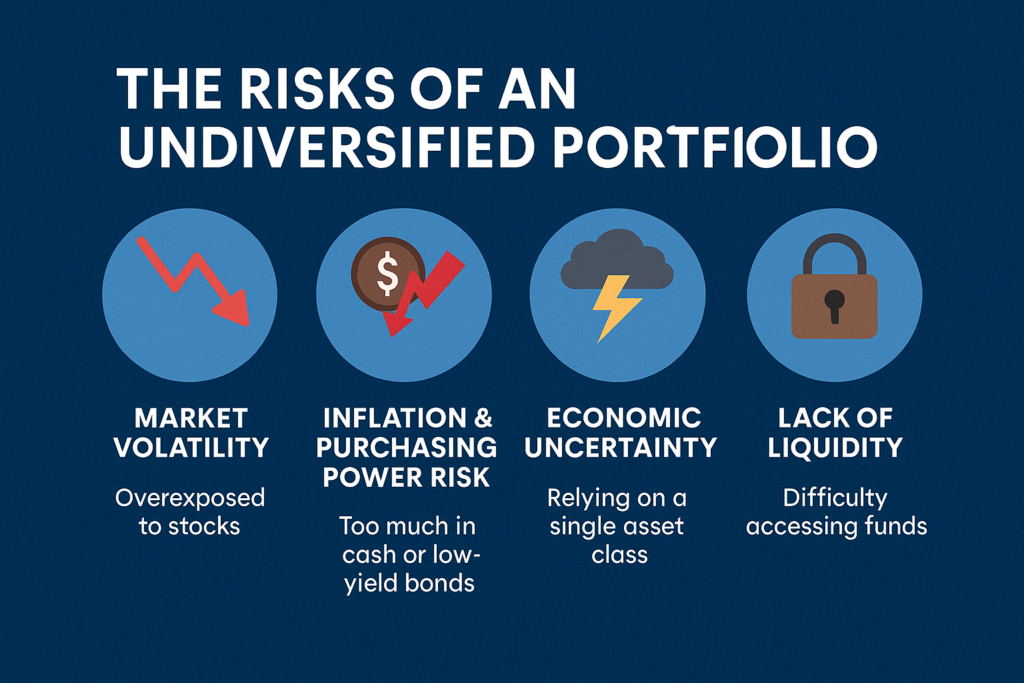
Why Putting All Your Eggs in One Basket is a Risky Move
Many investors make the mistake of concentrating their investments in a single asset class whether it’s stocks, bonds, or real estate. While this may work in strong economic conditions, it exposes portfolios to significant risks when markets shift.
Market crashes, inflation, and economic downturns can wipe out wealth quickly if your investments aren’t properly diversified. A 2024 study from J.P. Morgan Asset Management found that portfolios with diversified assets had 35% lower volatility and performed significantly better during bear markets.
At Navigator Wealth Fund, we emphasize diversification beyond traditional investments, using alternative assets and income-producing strategies to create a balanced and resilient portfolio.
The Risks of an Undiversified Portfolio

🚨 Market Volatility – If you’re overexposed to stocks, a market downturn could erode your wealth overnight.
🚨 Inflation & Purchasing Power Risk – Keeping too much in cash or low-yield bonds means losing real value as inflation rises.
🚨 Economic Uncertainty – Relying on a single asset class (like real estate) can backfire if that market experiences a downturn.
🚨 Lack of Liquidity – Some investments take time to sell or convert into cash, making it harder to access funds when needed.
These challenges highlight the need for a well-balanced portfolio that includes multiple asset classes to minimize risk and maximize returns.
How Diversification Strengthens Your Portfolio
Diversification is about spreading risk across different investments so that no single downturn can derail your financial future.
✅ 1. Combining Stocks, Bonds & Alternative Investments
A well-diversified portfolio includes equities for growth, bonds for stability, and alternative investments for passive income and inflation protection.
📌 A 2024 study from BlackRock found that investors who allocated at least 20% of their portfolio to alternative assets had higher risk-adjusted returns over a 10-year period compared to those who only held stocks and bonds.
✅ 2. Allocating to Cash-Flow Generating Assets
Investments like private lending, real estate debt, and dividend stocks provide steady income regardless of market conditions.
📌 According to Cambridge Associates, portfolios with at least 15% in private debt experienced lower volatility and stronger long-term performance than traditional fixed-income strategies.
✅ 3. Hedging Against Inflation & Market Swings
Inflation erodes savings over time, making real assets like real estate, private debt, and commodities essential inflation hedges.
| Asset Class | Purpose | Risk | Return |
| Stocks | Growth | High | Variable |
| Bonds | Stability | Low | Modest |
| Alternatives | Income + Hedge | Moderate | High |
📌 A 2024 report from NAREIT found that real estate investments have historically outpaced inflation by an average of 3% per year, providing a strong defense against rising costs.
Building a Resilient Investment Strategy
The best investors don’t chase short-term gains they focus on long-term stability, income, and risk management. By diversifying across multiple asset classes, you can protect your wealth, reduce volatility, and create a sustainable financial future.
📩 Want to learn how alternative investments can strengthen your portfolio?
Navigator Wealth Fund offers private lending investments designed to deliver 8-11% preferred returns while maintaining capital security.
👉 Learn more today: https://navwf.com/Bonus
Disclaimer: The information provided in this post is for informational purposes only and does not constitute financial or legal advice. Please consult with a qualified financial advisor, CPA or attorney before making any investment decisions.
